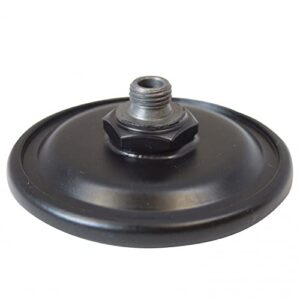To change the shift solenoid on a Ford F150, first, locate the shift solenoid on the transmission, then disconnect the electrical connector and remove the old solenoid. Install the new solenoid and reattach the electrical connector.
Use a reliable guide or seek professional help if you’re unsure about the process to avoid damaging your vehicle. The shift solenoid is a critical component of the transmission system in your Ford F150.
If you’re experiencing issues such as erratic shifting, delayed or harsh shifting, or failure to shift, it may be time to replace the shift solenoid.
This guide will walk you through the steps to change the shift solenoid on your Ford F150, ensuring smooth and efficient gear changes for your vehicle’s optimal performance.
Table of Contents
Symptoms Of A Faulty Shift Solenoid
If you’re experiencing issues with shifting gear in your Ford F150, it could be a sign of a faulty shift solenoid. The shift solenoid is a crucial component of the transmission system that controls the flow of transmission fluid and helps to facilitate gear changes.
When it malfunctions, it can lead to a range of problems that affect the performance and drivability of the vehicle.
Common Vehicle Behavior
When the shift solenoid in your Ford F150 is faulty, you may notice the following common vehicle behaviors:
- Delayed or rough shifting between gears
- Inability to shift into certain gears
- Transmission slippage
- Unexpected shifting patterns
- Erratic or unpredictable behavior
Diagnostic Trouble Codes
In the event of a faulty shift solenoid, the vehicle’s onboard diagnostics may detect specific trouble codes, such as:
| Diagnostic Trouble Code | Description |
|---|---|
| P0750 | Shift Solenoid ‘A’ Malfunction |
| P0755 | Shift Solenoid ‘B’ Malfunction |
| P0760 | Shift Solenoid ‘C’ Malfunction |
| P0765 | Shift Solenoid ‘D’ Malfunction |
| P2703 | Transmission Friction Element ‘E’ Apply Time Range/Performance |
Understanding these symptoms and diagnostic trouble codes can help you diagnose and address a faulty shift solenoid in your Ford F150.
Gathering Necessary Tools And Materials
When it comes to maintaining and repairing your Ford F150, having the right tools and replacement parts on hand is crucial for a successful shift solenoid replacement.
Gathering the necessary tools and materials in advance will ensure that you can efficiently complete the task and avoid any unnecessary trips to the hardware store.
Below we’ll cover the list of tools you’ll need and the required replacement parts to get the job done.
List Of Tools
- Socket wrench set
- Screwdriver set
- Jack and jack stands
- Allen wrench set
- Wire brush
- Ratchet set
- Shop towels
- Container for storing small parts
Required Replacement Parts
- Replacement shift solenoid
- Transmission fluid (if needed)
- Gasket or sealant (if needed)
- Clean rags or towels
- Protective gloves
- Safety goggles
Vehicle Preparation
When changing the shift solenoid on your Ford F150, proper vehicle preparation is essential to ensure a safe and efficient process.
By following the necessary steps for vehicle preparation, you can access the transmission and effectively replace the shift solenoid.
Safety Precautions
Before beginning any work on the vehicle, it is crucial to adhere to safety precautions to prevent any accidents or injuries. Make sure to wear protective gear, such as gloves and safety goggles, to shield yourself from potential hazards.
Always work in a well-ventilated area to avoid exposure to harmful fumes, and ensure the vehicle is parked on a flat, stable surface before initiating any repairs.
Accessing The Transmission
Accessing the transmission is the initial step in changing the shift solenoid. To begin, locate the transmission fluid pan and carefully remove any obstructions that may impede access.
Utilize a floor jack to elevate the vehicle, and securely support it using jack stands to provide ample clearance for accessing the transmission from beneath the vehicle.
Once these steps are completed, you can proceed with the process of replacing the shift solenoid with ease and precision.
Locating The Shift Solenoid
When it comes to your Ford F150’s transmission, understanding how to locate and change the shift solenoid is crucial for maintaining the vehicle’s optimal performance.
The shift solenoid is a critical component that helps regulate the flow of transmission fluid and the shifting of gears. In this section, we will cover the overview of the transmission and how to identify the specific solenoid.
Transmission Overview
The transmission in a Ford F150 is responsible for transferring power from the engine to the wheels, allowing the vehicle to shift gears and operate smoothly.
The importance of maintaining the transmission cannot be overstated, and regular maintenance includes monitoring the shift solenoid to ensure proper function.
Identifying The Specific Solenoid
Locating the shift solenoid in your Ford F150 is the first step in the process of changing it. The shift solenoid is typically located within the transmission housing, and its exact placement may vary based on the specific model year of your vehicle.
Refer to your F150’s service manual or consult with a professional mechanic to pinpoint the precise location of the shift solenoid.
Removing The Faulty Solenoid
When it comes to addressing issues with your Ford F150’s shift solenoid, it’s crucial to understand the step-by-step process of removing the faulty component.
This is a critical part of the overall repair process, and attention to detail is essential to ensure the successful replacement of the shift solenoid.
In this section, we will delve into the step-by-step removal process and provide valuable tips for handling delicate components.
Step-by-step Removal Process
Here is a detailed breakdown of the step-by-step process for removing the faulty shift solenoid from your Ford F150:
- Start by locating the transmission fluid pan, typically positioned underneath the vehicle.
- Once the pan is located, carefully remove the bolts securing it in place using a suitable wrench or socket set.
- Next, gently lower the transmission fluid pan to access the internal components, being mindful of any residual fluid that may drain out.
- Identify the shift solenoid within the transmission housing, noting its position and orientation.
- Using a suitable set of tools, carefully disconnect the electrical connector attached to the shift solenoid, ensuring no excessive force is applied to prevent damage.
- With the electrical connector removed, proceed to unscrew the mounting bolts or fasteners securing the shift solenoid in place.
- Carefully maneuver the shift solenoid out of its housing, taking note of any seals or gaskets that may require replacement during reinstallation.
- Inspect the surrounding area for any signs of debris or wear that may have contributed to the shift solenoid’s failure, addressing any issues as needed.
Tips For Handling Delicate Components
When dealing with the intricate components of the shift solenoid and its surrounding elements, it’s essential to exercise caution and precision.
Here are some tips for handling delicate components during the removal process:
- Exercise patience and avoid rushing through any steps, as precision and care are vital to prevent damage to the shift solenoid or other related parts.
- Utilize suitable tools designed for the task at hand, ensuring that they are in good condition and well-suited for the specific components being handled.
- Take note of the position and orientation of any components being removed, as this will aid in the reassembly process and prevent errors during installation.
- Be mindful of any electrical connections, ensuring that they are disconnected with care to avoid damage to the wiring or connectors.
- Keep track of any fasteners, bolts, or small parts to prevent misplacement, utilizing labeled containers or trays to organize these items as they are removed.
Installing The New Shift Solenoid
When it comes to installing a new shift solenoid in your Ford F150, proper alignment and insertion are crucial for a successful replacement.
Once you have removed the old solenoid and are ready to install the new one, following the right steps is essential for optimal performance.
In this section, we will cover the proper alignment and insertion as well as securing the solenoid in place, ensuring a seamless installation process.
Proper Alignment And Insertion
Proper alignment and insertion of the new shift solenoid are essential to ensure it functions correctly. To align and insert the solenoid:
- Position the new solenoid in the same orientation as the old one.
- Align the mounting holes on the solenoid with the corresponding holes on the transmission housing.
- Carefully insert the solenoid into place, ensuring it fits snugly without any forceful maneuvers.
Securing The Solenoid In Place
Once the solenoid is properly aligned and inserted, securing it in place is the next step to complete the installation process. To secure the solenoid:
- Use the provided mounting hardware to fasten the solenoid to the transmission housing.
- Tighten the bolts evenly to ensure the solenoid is securely fastened without any uneven pressure.
- Double-check the alignment and ensure the solenoid is firmly in place before proceeding to reconnect any electrical connectors.
Reassembling The Transmission
Reassembling the transmission of a Ford F150 after replacing the shift solenoid is a critical step to ensure proper functioning and longevity of the vehicle.
Following a systematic approach and paying attention to detail is essential in this process.
Reverse Of Removal Process
When reassembling the transmission, it’s crucial to follow the reverse of the removal process.
Begin by carefully replacing the components in the exact order they were removed, ensuring that each piece fits snugly into place.
Ensuring All Components Are Secured
After placing each component back into the transmission, take the time to ensure they are secured properly.
Check for any loose fittings or connections and tighten them as needed. This step is vital to prevent any potential leaks or malfunctions in the future.
Functional Testing
Functional testing of the shift solenoid on a Ford F150 is crucial to ensure smooth transmission operation.
It involves a series of steps to verify the proper function and performance of the solenoid. Here’s how to perform functional testing on the shift solenoid.
Verifying Proper Solenoid Function
Before replacing the shift solenoid on your Ford F150, it’s important to verify that the solenoid is the actual cause of the transmission issues. This can be done by:
- Performing a diagnostic scan to check for trouble codes related to the shift solenoid.
- Testing the solenoid with a multimeter to ensure proper electrical continuity.
- Checking the solenoid for any physical damage or debris that may be causing it to malfunction.
Test Driving The Vehicle
After replacing the shift solenoid, it’s crucial to test drive the vehicle to ensure that the transmission is operating smoothly. This involves:
- Engaging each gear to ensure proper shifting without any hesitation or jerking.
- Observing the transmission’s response during acceleration and deceleration.
- Checking for any warning lights or error codes that may appear during the test drive.
Frequently Asked Questions
How Do I Know If My Ford F150 Has A Shift Solenoid Problem?
If your Ford F150 is having trouble shifting gears, experiencing erratic shifting, or showing a “check engine” light, it could indicate a shift solenoid issue. It’s essential to have it diagnosed by a professional to confirm the problem.
What Are The Common Signs Of A Faulty Shift Solenoid In A Ford F150?
Key indicators of a malfunctioning shift solenoid in a Ford F150 include delayed or rough shifting, the transmission getting stuck in a particular gear, and the vehicle’s inability to engage a specific gear. It’s crucial to address these symptoms promptly to prevent further damage.
Can I Replace The Shift Solenoid On A Ford F150 Myself?
While some confident DIYers may attempt to replace a shift solenoid, it’s recommended to have a professional handle the task. A qualified mechanic possesses the expertise and tools required to perform the replacement accurately, ensuring the proper function of the transmission system.
Conclusion
Replacing the shift solenoid on your Ford F150 is a manageable task with basic mechanical know-how. Regular maintenance and care for your transmission system can help prevent issues in the long run.
By following the steps outlined in this guide, you can keep your truck running smoothly for years to come.




